| DESCRIPTION | HISTORY |
Please Click On Any Picture for a Larger Version
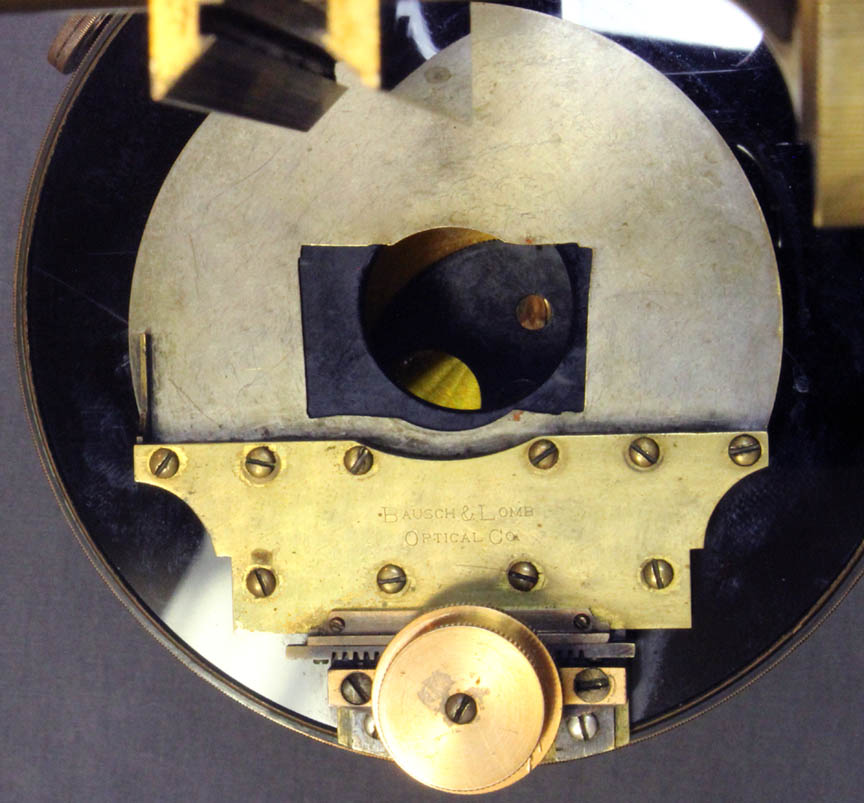
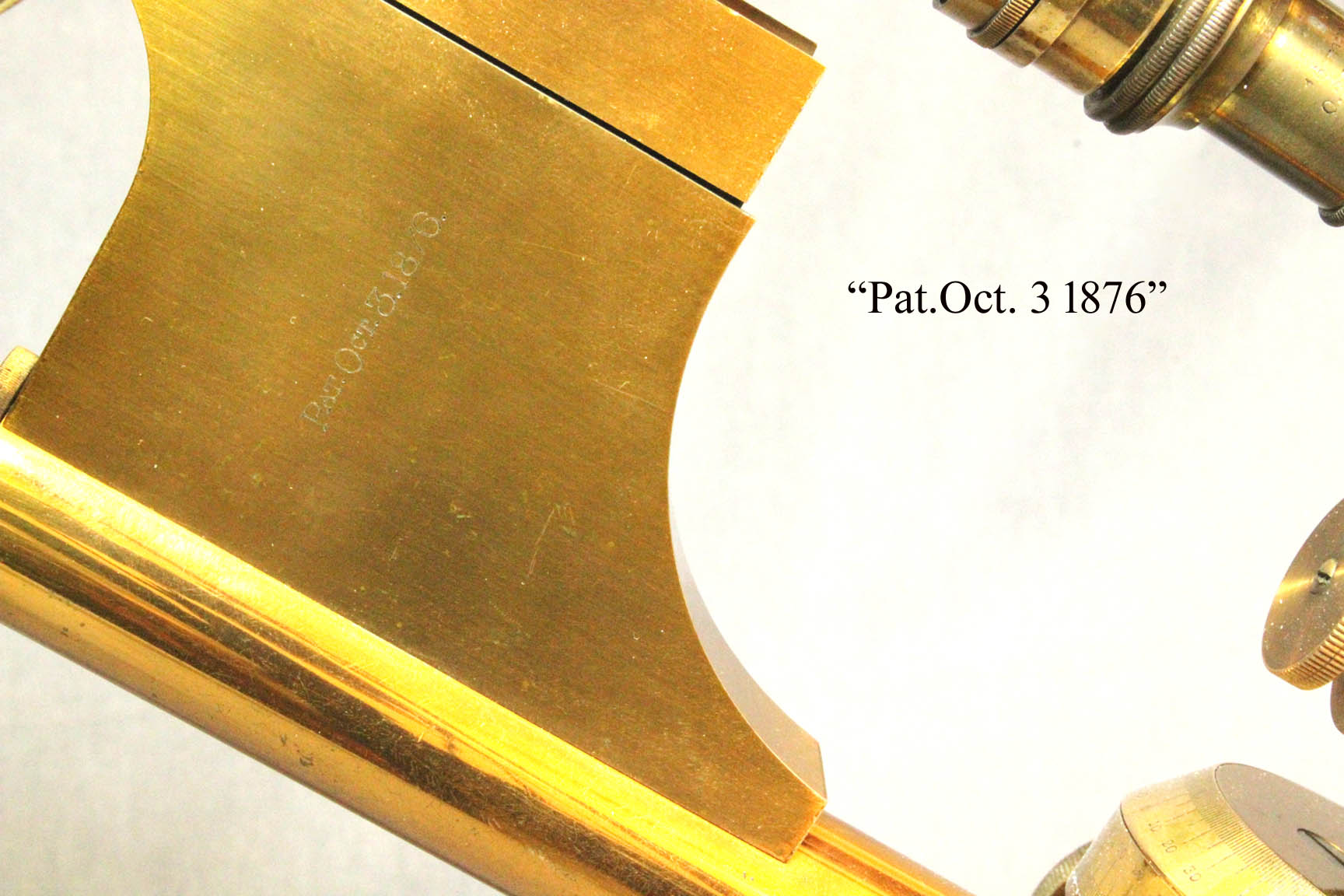 This microscope, which shares several features with the Walter Bulloch Congress microscope of 1882, is signed on the stage and the tripod base(foot) 'Bausch & Lomb Optical Co'. The arm of the limb is engraved with the patent date of Oct 3, 1876. This microscope is an example of the B&L Professional Model. Since the 1885 patent date is not on the microscope, and its features are much more modern than the 1876 patent date, it is likely that it was made in the early 1880s. At the time this microscope was produced, it was the top of the line model sold by the firm. This large and heavy microscope is constructed completely in lacquered brass, with the exception of the foot which is lead-filled brass, coated with a golden-color finish commonly used by Bausch & Lomb at the time, and Nickel plated brass to the drawtube. It measures about 19 inches tall as shown in the photographs. The tube length can be adjusted by raising the nickel plated draw-tube.
This microscope, which shares several features with the Walter Bulloch Congress microscope of 1882, is signed on the stage and the tripod base(foot) 'Bausch & Lomb Optical Co'. The arm of the limb is engraved with the patent date of Oct 3, 1876. This microscope is an example of the B&L Professional Model. Since the 1885 patent date is not on the microscope, and its features are much more modern than the 1876 patent date, it is likely that it was made in the early 1880s. At the time this microscope was produced, it was the top of the line model sold by the firm. This large and heavy microscope is constructed completely in lacquered brass, with the exception of the foot which is lead-filled brass, coated with a golden-color finish commonly used by Bausch & Lomb at the time, and Nickel plated brass to the drawtube. It measures about 19 inches tall as shown in the photographs. The tube length can be adjusted by raising the nickel plated draw-tube. 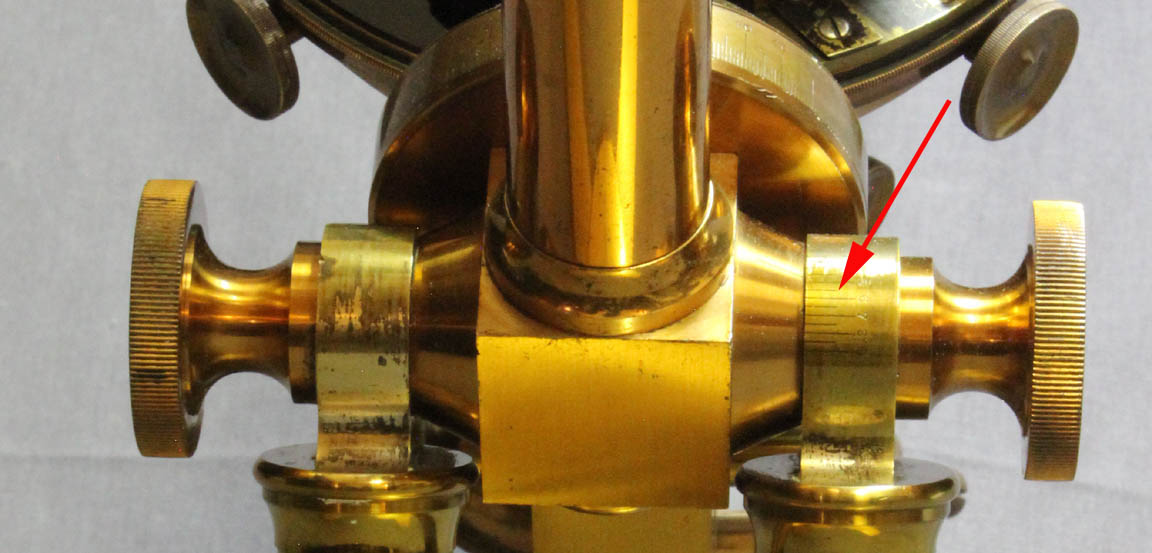 Rising from the tripod base are two turned pillars that support the body of the microscope. Tension for the inclination of the microscope can be adjusted using brass knobs located on either side of the axis of inclination. The angle of inclination is calibrated with silvered scales (red arrow).
Rising from the tripod base are two turned pillars that support the body of the microscope. Tension for the inclination of the microscope can be adjusted using brass knobs located on either side of the axis of inclination. The angle of inclination is calibrated with silvered scales (red arrow).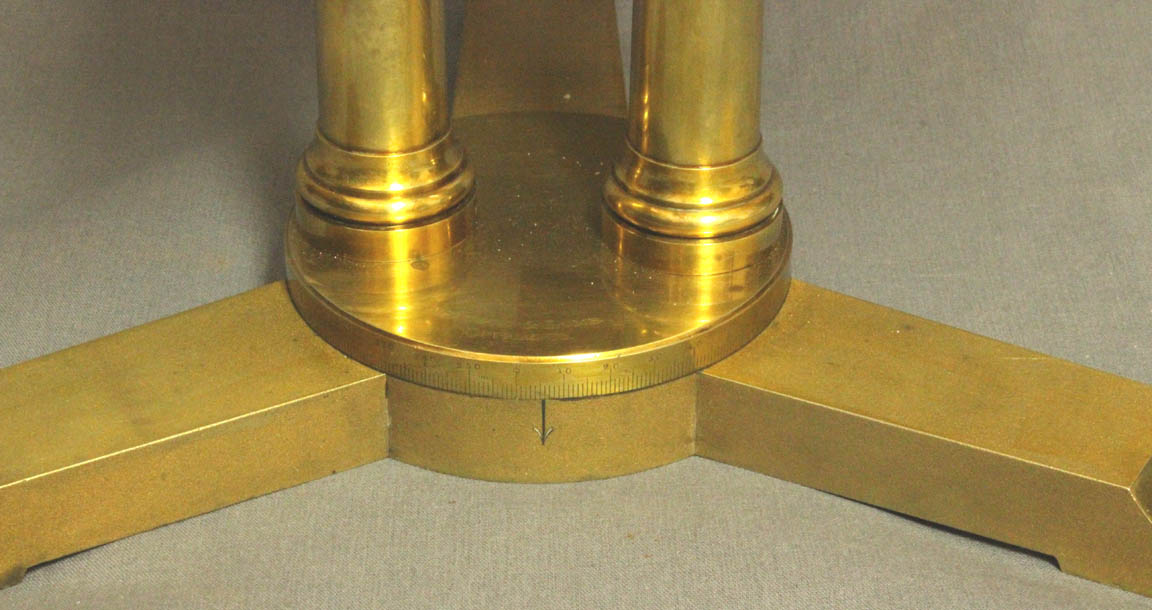 The pillars rest on a circular lacquered brass plate with a calibrated scale(not silvered but rather engraved on the lacquered brass) on which the entire instrument can rotate on the flat tripod foot. The scale registers on an upside down arrow on the foot. The purpose of this feature, first introduced by Joseph Zentmayer in the Grand American model, was to allow measurement of the angular aperture of objectives-a measure of the resolving power of the objectives. For more about the assessment of the aperture as a measurement of resolving power, see the History of the Apertometer page.
The pillars rest on a circular lacquered brass plate with a calibrated scale(not silvered but rather engraved on the lacquered brass) on which the entire instrument can rotate on the flat tripod foot. The scale registers on an upside down arrow on the foot. The purpose of this feature, first introduced by Joseph Zentmayer in the Grand American model, was to allow measurement of the angular aperture of objectives-a measure of the resolving power of the objectives. For more about the assessment of the aperture as a measurement of resolving power, see the History of the Apertometer page.
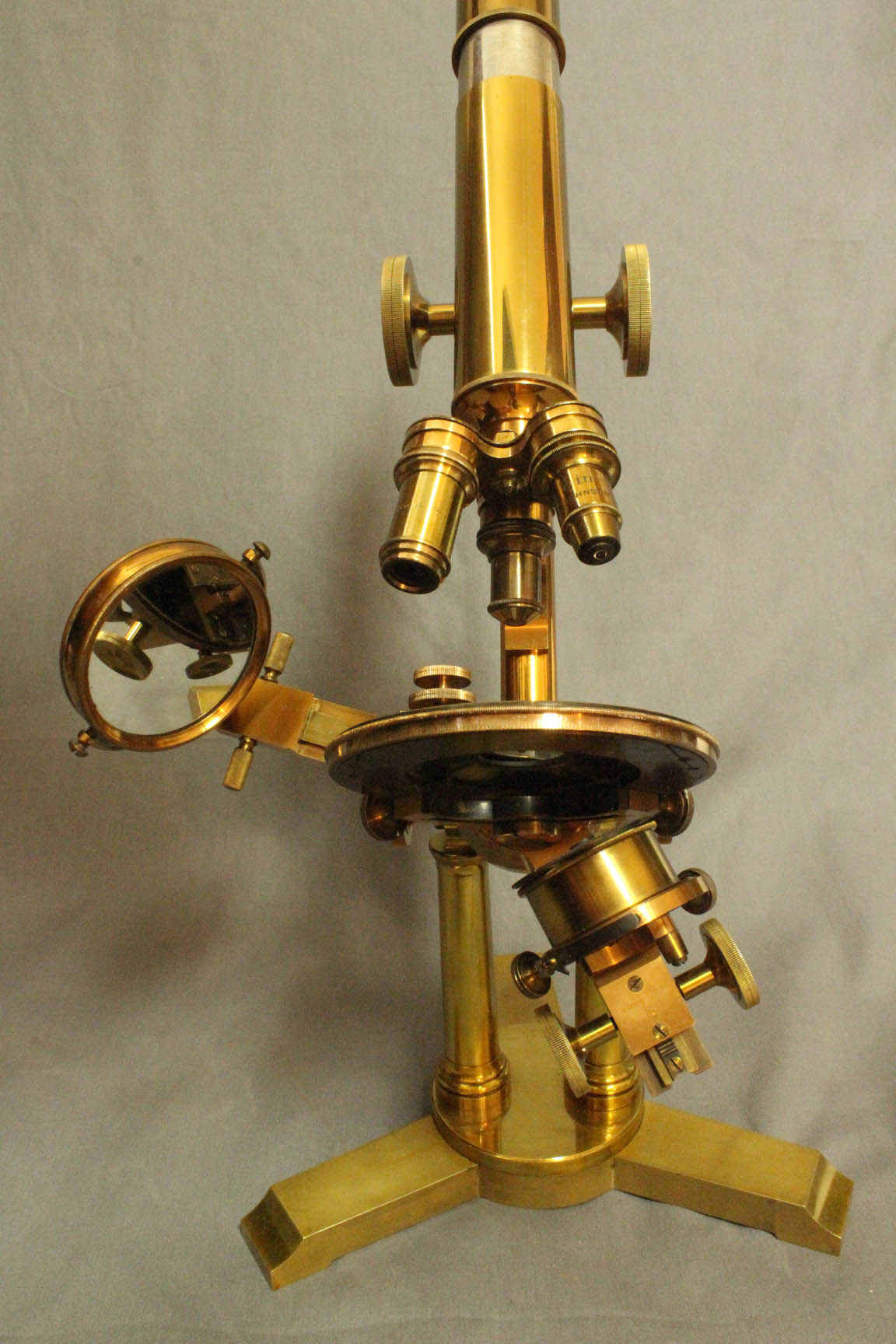
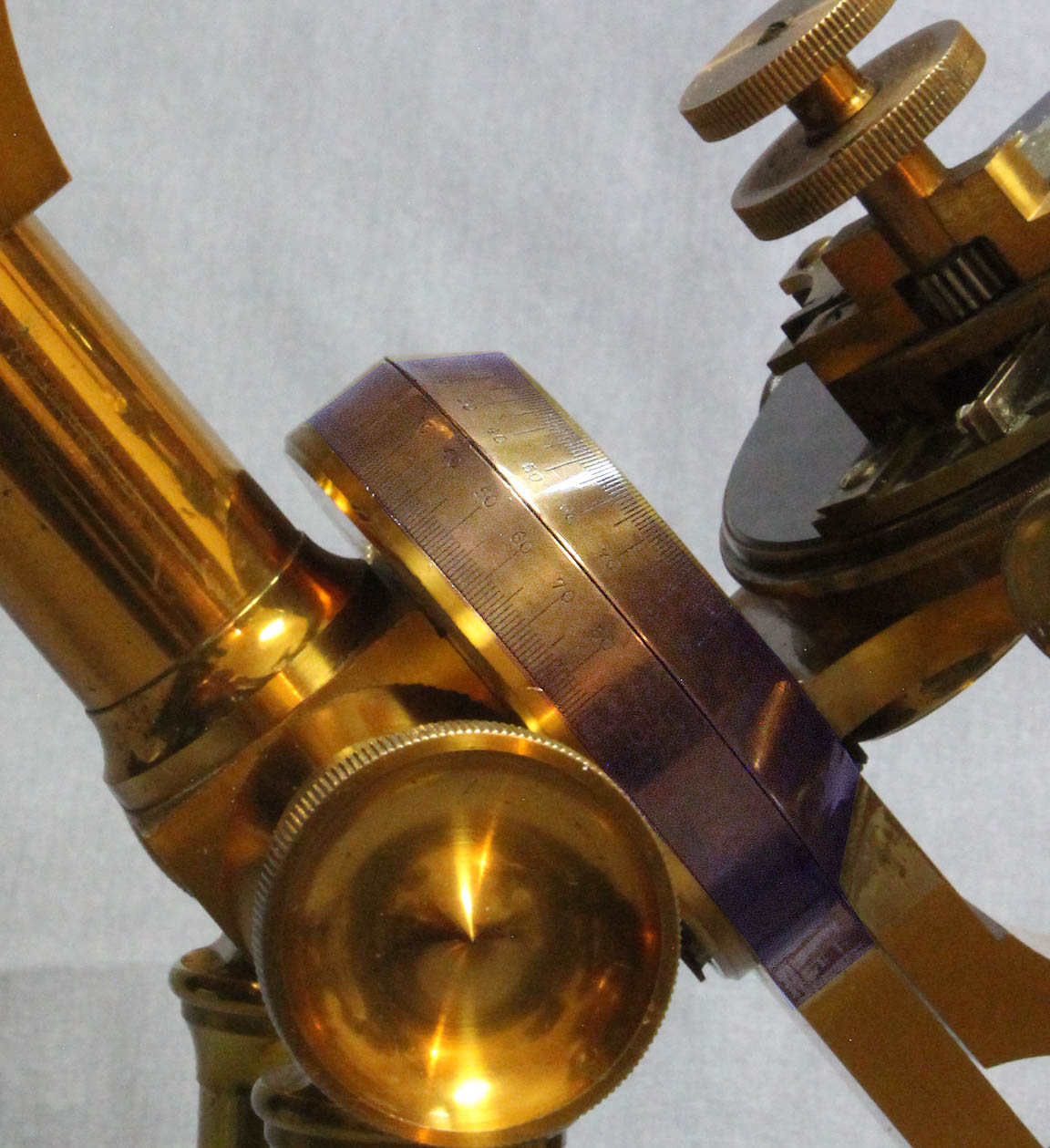 The mirror arm(tailpiece) and sub-stage arm(2nd tailpiece) are mounted on a single axis but can move independently; both arms are capable of being oriented, together or separately, in any position including above the stage. Although the practice of having the tailpiece rotate through the axis of the specimen slide was popularized by Zentmayer, the use of two separate rotatable tailpieces with both their axes through the level of the slide, is a form invented by Walter Bulloch. Calibrated independent silvered scales measure the degree of movement of each arm. Because the movements of the substage components were designed so that the axis of rotation of the arms are in the plane of the specimen, once focused,the illumination remains in focus regardless of the angle of illumination.
The mirror arm(tailpiece) and sub-stage arm(2nd tailpiece) are mounted on a single axis but can move independently; both arms are capable of being oriented, together or separately, in any position including above the stage. Although the practice of having the tailpiece rotate through the axis of the specimen slide was popularized by Zentmayer, the use of two separate rotatable tailpieces with both their axes through the level of the slide, is a form invented by Walter Bulloch. Calibrated independent silvered scales measure the degree of movement of each arm. Because the movements of the substage components were designed so that the axis of rotation of the arms are in the plane of the specimen, once focused,the illumination remains in focus regardless of the angle of illumination. 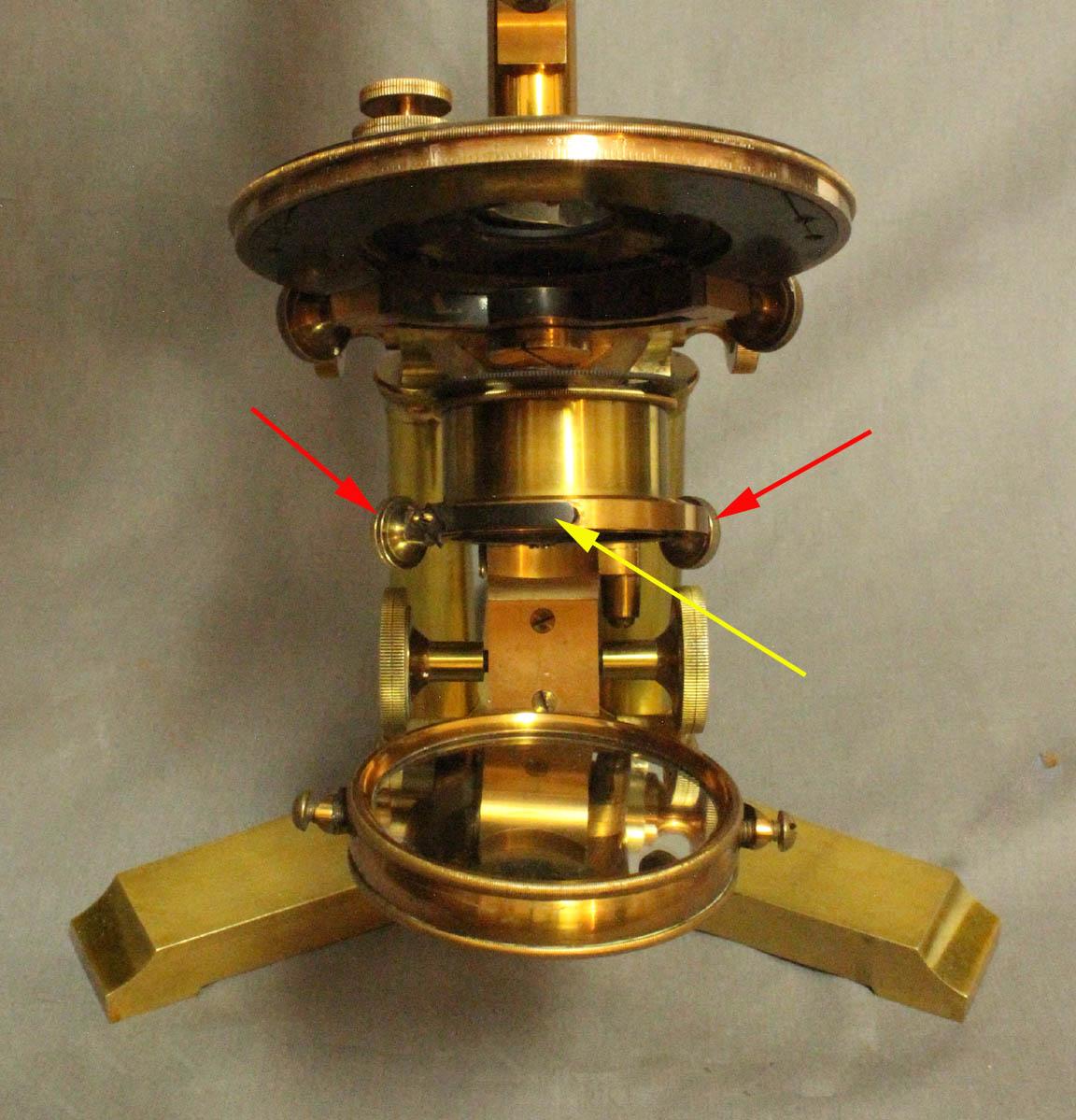
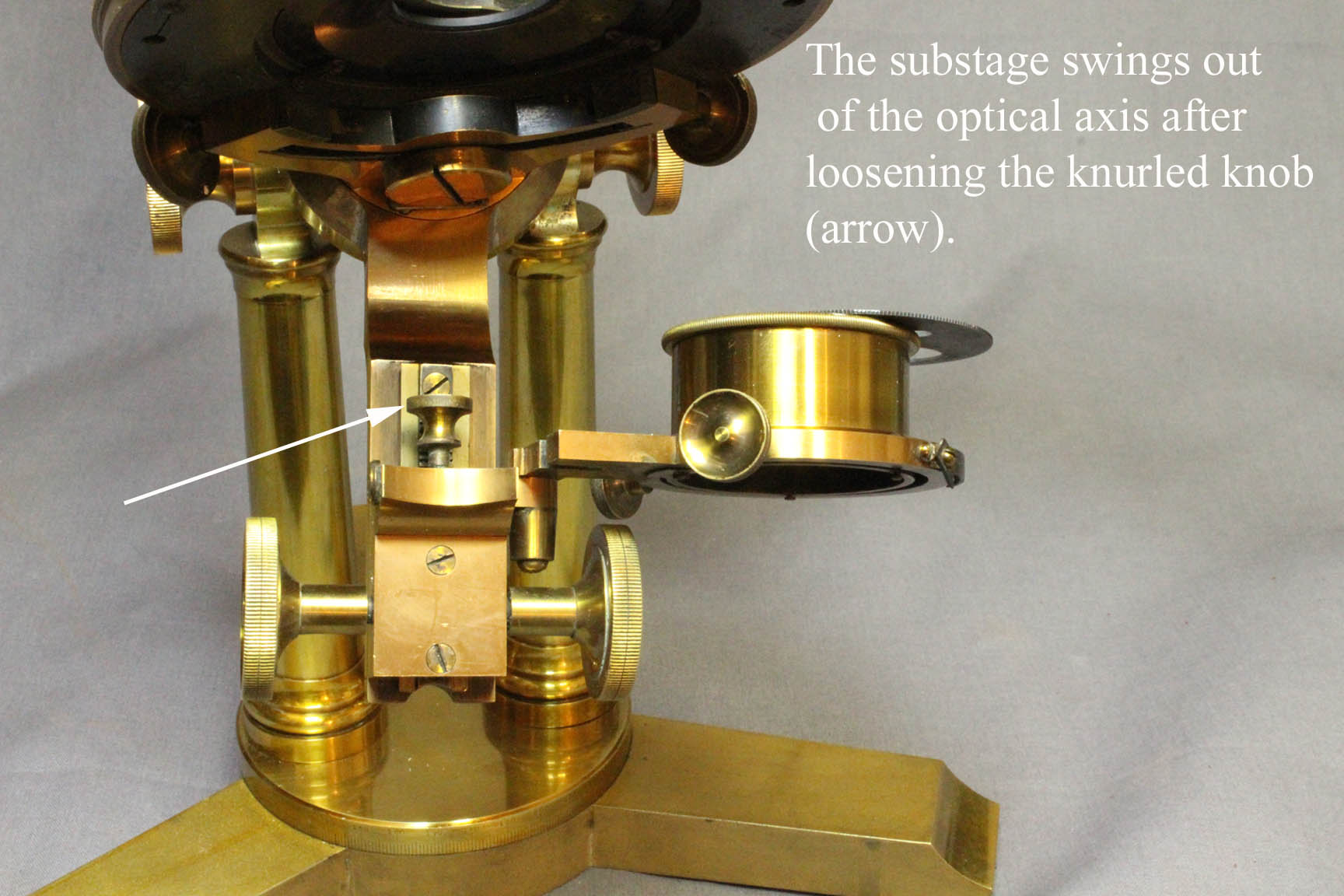 The substage focuses by straight rack and pinion and has provision for centering by two knurled knobs(red arrows). The yellow arrow points to the tensioning spring which pushes on a pin which keeps the sleeve taut against the adjustment knobs. The substage sleeve can also be turned completely out of the optical axis via a hinge or it can be locked into the optical axis via a small vertically-positioned knurled knob. The substage sleeve has provision for centering and on this example is fitted with a easily removed wheel of apertures. The substage sleeve is held locked in its normal axial position by a knurled knob. Once this knob is loosened, the substage housing can be rotated completely out of the optical axis.
The mirrors are plane and concave, of large size, and are adjustable along the mirror-bar.
The substage focuses by straight rack and pinion and has provision for centering by two knurled knobs(red arrows). The yellow arrow points to the tensioning spring which pushes on a pin which keeps the sleeve taut against the adjustment knobs. The substage sleeve can also be turned completely out of the optical axis via a hinge or it can be locked into the optical axis via a small vertically-positioned knurled knob. The substage sleeve has provision for centering and on this example is fitted with a easily removed wheel of apertures. The substage sleeve is held locked in its normal axial position by a knurled knob. Once this knob is loosened, the substage housing can be rotated completely out of the optical axis.
The mirrors are plane and concave, of large size, and are adjustable along the mirror-bar.
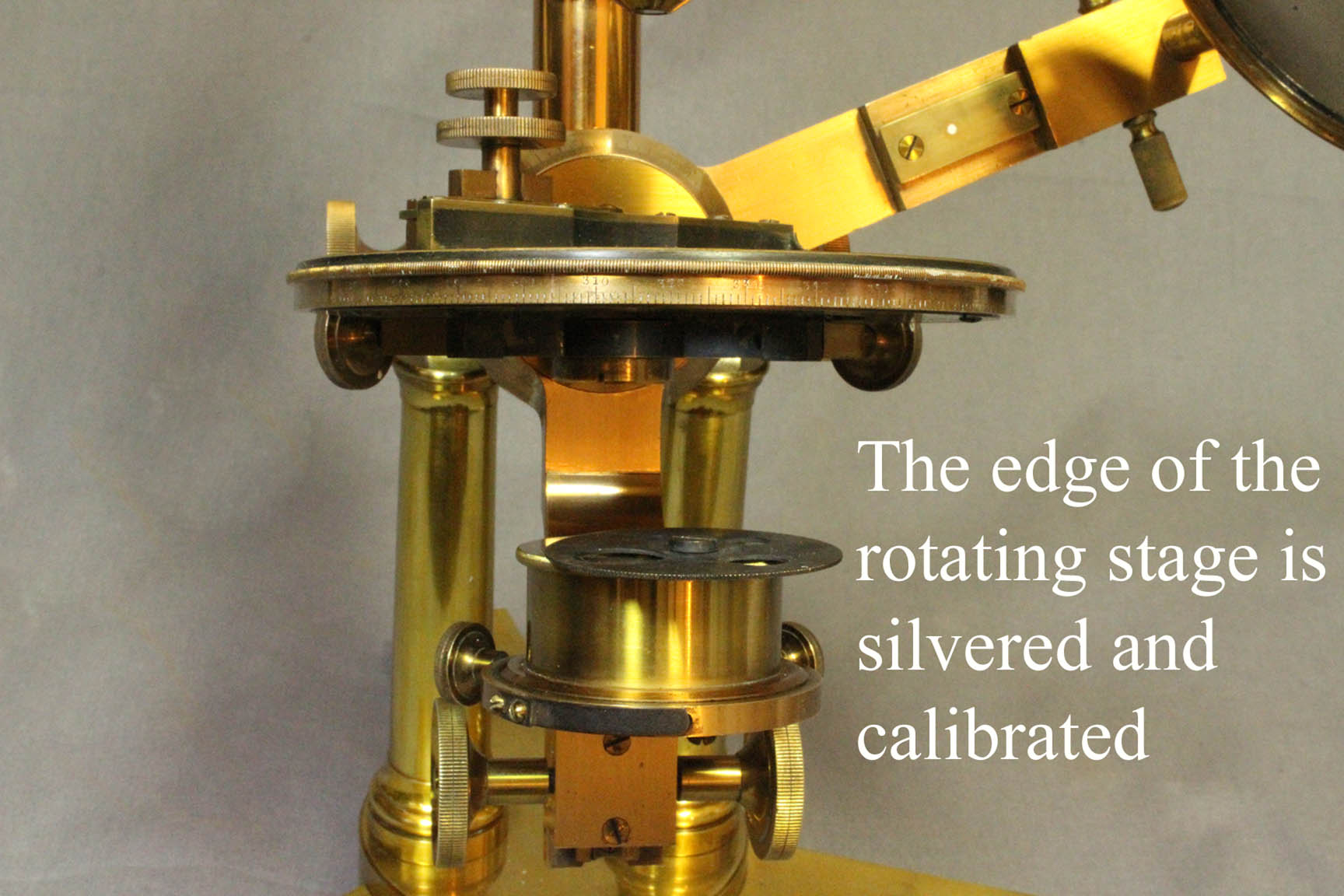 This example has the B & L version of mechanical stage which can be fully rotated because the concentric adjustment knobs are oriented vertically. The angle of rotation of the stage is measured by a calibrated engraved silvered scale on the rim of the stage. This type of stage was described in the JRMS of 1887, but a very similar design by Walter Bulloch was described earlier, in 1882 and also reported in that Journal. Bulloch gave credit to Charles Spencer for the origination of this type of control of the stage, although the author has not seen an example of this stage on a Spencer microscope. The concept of concentric controls for control of the mechanical stage, though oriented horizontally, is usually credited to Edward Turrell, as described in 1832-3. Although the vertically oriented controls allow the stage to rotate a full 360 degrees, the knobs protruding upwards can hit the other objectives on the triple nosepiece that are not in use at the time; this disadvantage may explain why the horizontal orientation remained more common. Unlike B & L's triple nosepiece, Bulloch solved this problem by designing a multiple nosepiece that angled the rotation of the objectives in such a way that the objectives not in use were oriented more towards the horizontal, and raising their ends further away from the stage controls. Thus on the Bulloch Congress in this collection, the objective not in use does not interfere with full stage rotation. Another solution popularized by Watson and seen on the Grand Van Heurck Microscope, is simply moving the optical axis forward away from the limb; in that microscope, and also the Circuit Stage Van Heurck, the limb is so far back from the optical axis that even the horizontal stage controls can pass without being obstructed by the limb. The B & L Professional has two opposing knobs that allow the mechanical stage to be centered on the optical axis.
This example has the B & L version of mechanical stage which can be fully rotated because the concentric adjustment knobs are oriented vertically. The angle of rotation of the stage is measured by a calibrated engraved silvered scale on the rim of the stage. This type of stage was described in the JRMS of 1887, but a very similar design by Walter Bulloch was described earlier, in 1882 and also reported in that Journal. Bulloch gave credit to Charles Spencer for the origination of this type of control of the stage, although the author has not seen an example of this stage on a Spencer microscope. The concept of concentric controls for control of the mechanical stage, though oriented horizontally, is usually credited to Edward Turrell, as described in 1832-3. Although the vertically oriented controls allow the stage to rotate a full 360 degrees, the knobs protruding upwards can hit the other objectives on the triple nosepiece that are not in use at the time; this disadvantage may explain why the horizontal orientation remained more common. Unlike B & L's triple nosepiece, Bulloch solved this problem by designing a multiple nosepiece that angled the rotation of the objectives in such a way that the objectives not in use were oriented more towards the horizontal, and raising their ends further away from the stage controls. Thus on the Bulloch Congress in this collection, the objective not in use does not interfere with full stage rotation. Another solution popularized by Watson and seen on the Grand Van Heurck Microscope, is simply moving the optical axis forward away from the limb; in that microscope, and also the Circuit Stage Van Heurck, the limb is so far back from the optical axis that even the horizontal stage controls can pass without being obstructed by the limb. The B & L Professional has two opposing knobs that allow the mechanical stage to be centered on the optical axis. 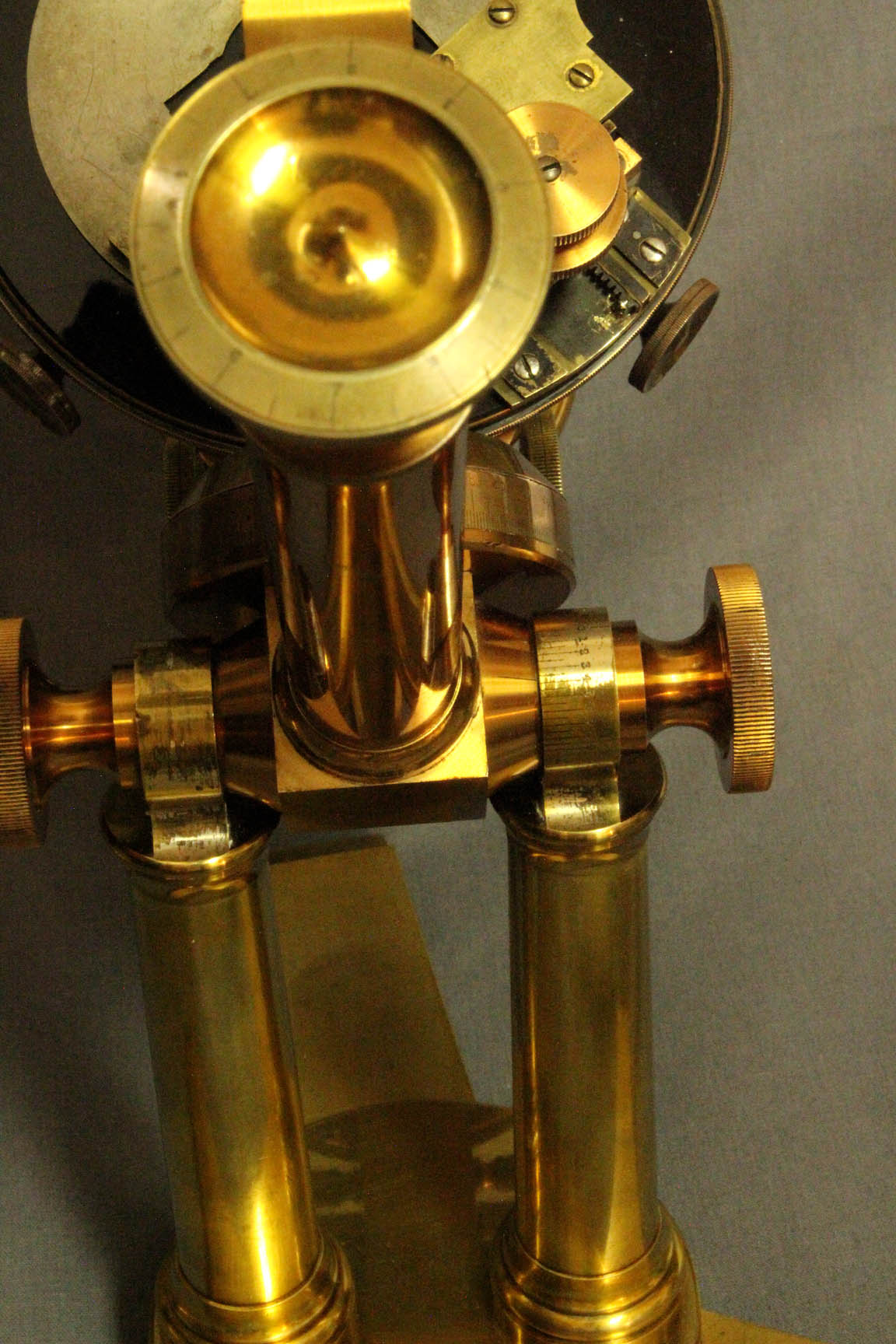 The main tube focuses by straight rack and pinion. The fine adjustment knob is silvered, and is located in the rear and is the subject of the 1876 patent.
The main tube focuses by straight rack and pinion. The fine adjustment knob is silvered, and is located in the rear and is the subject of the 1876 patent.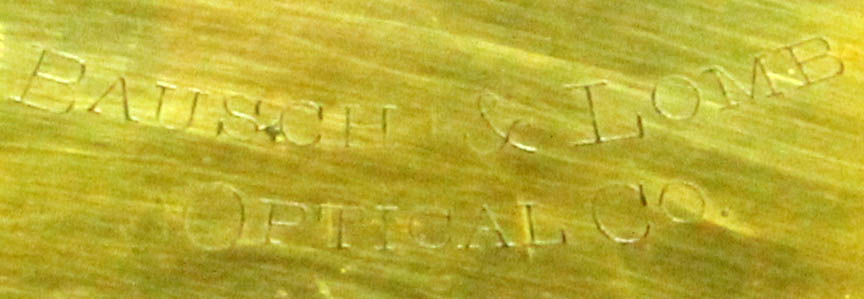 The foot is a B&L variation, commonly found on other stands by them, and is signed 'Bausch & Lomb, Optical Co.' As mentioned above, it is made of relatively thin brass filled with lead and with a golden applied-finish rather than a lacquered brass finish found on most of the rest of the microscope. The exact way this finish was applied, and its purpose is not known. One theory is that it is more durable than a lacquered brass finish in a place chemicals are more likely to spill, but I have no proof of that idea, and I have seen plenty of feet with these finishes marred by prior spills.
The foot is a B&L variation, commonly found on other stands by them, and is signed 'Bausch & Lomb, Optical Co.' As mentioned above, it is made of relatively thin brass filled with lead and with a golden applied-finish rather than a lacquered brass finish found on most of the rest of the microscope. The exact way this finish was applied, and its purpose is not known. One theory is that it is more durable than a lacquered brass finish in a place chemicals are more likely to spill, but I have no proof of that idea, and I have seen plenty of feet with these finishes marred by prior spills. 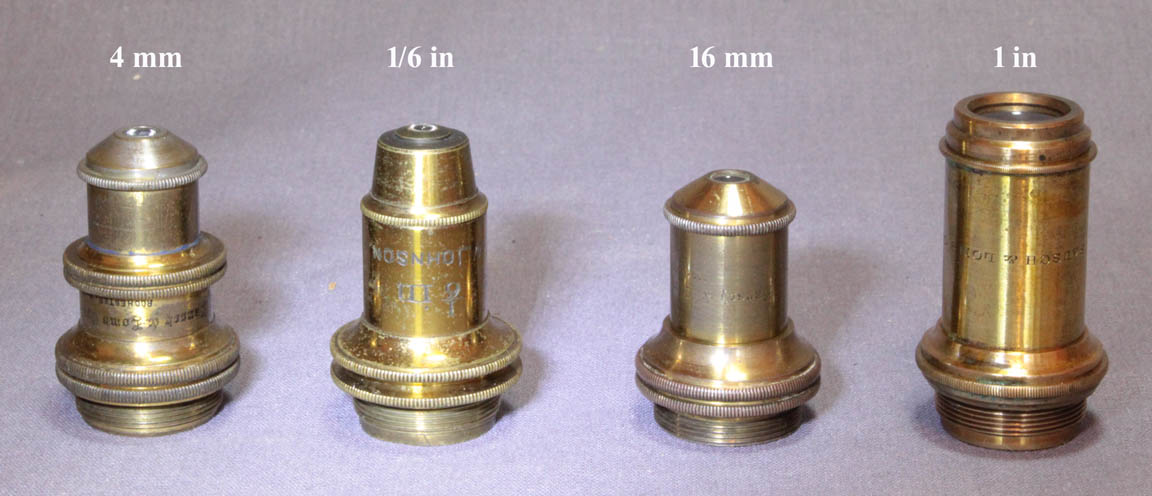 The microscope came to me with four objectives, a triple objective changer, and three eyepieces.
The microscope came to me with four objectives, a triple objective changer, and three eyepieces. 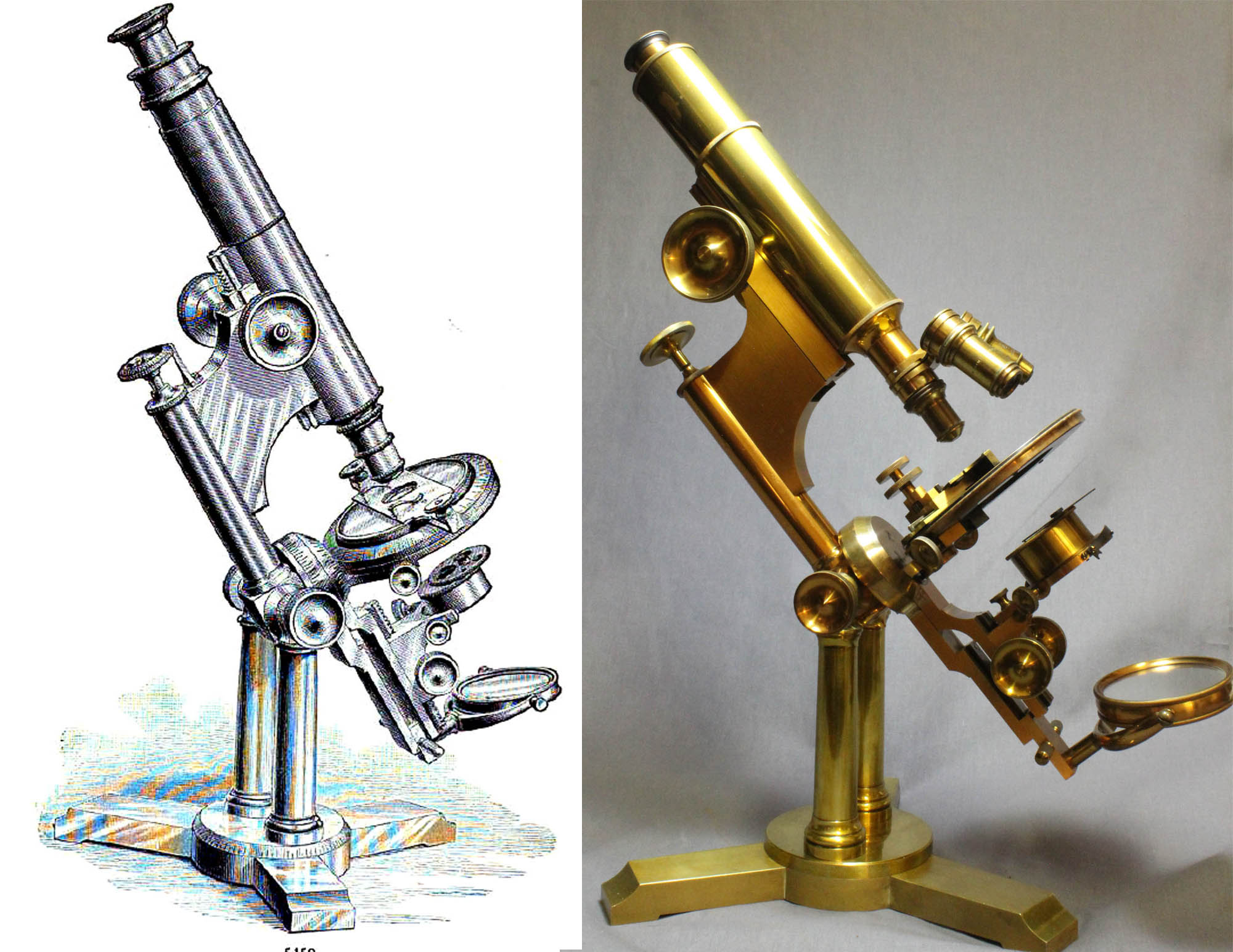 Bausch & Lomb began to produce compound microscopes about 1876. The top of the line was the Professional Model which evolved through several iterations, starting with a much more basic model designed by Ernst Gundlach. The version on this page is the more modern form but intermediate in the timeline between the initial more basic Gundlach design and the final version. The final version was produced about 1894. For a detailed review of the evolution of this stand, see the article by Allan Wissner, former owner of this microscope, on his site. I am grateful to Allan for his friendship, help and kindness in selling this model to me.
Bausch & Lomb began to produce compound microscopes about 1876. The top of the line was the Professional Model which evolved through several iterations, starting with a much more basic model designed by Ernst Gundlach. The version on this page is the more modern form but intermediate in the timeline between the initial more basic Gundlach design and the final version. The final version was produced about 1894. For a detailed review of the evolution of this stand, see the article by Allan Wissner, former owner of this microscope, on his site. I am grateful to Allan for his friendship, help and kindness in selling this model to me.